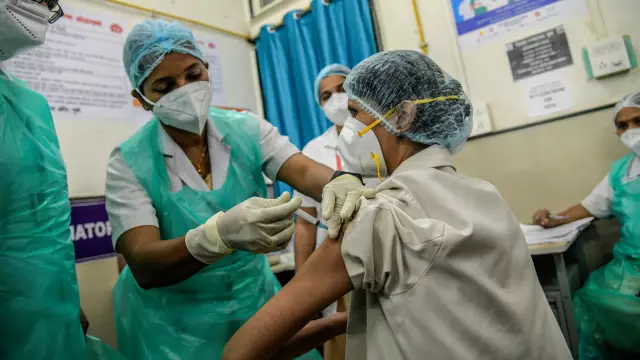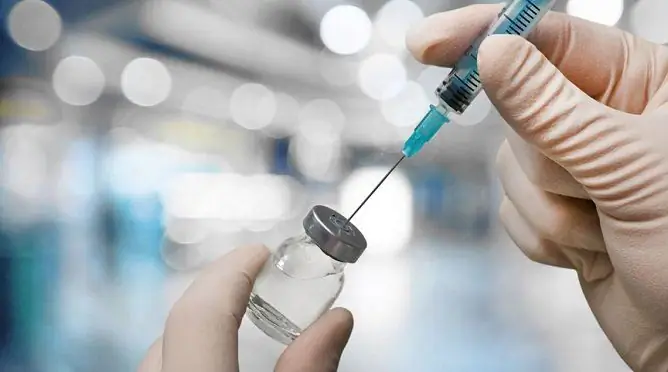- Author Rachel Wainwright [email protected].
- Public 2023-12-15 07:39.
- Last modified 2025-11-02 20:14.
Infanrix
Infanrix: instructions for use and reviews
- 1. Release form and composition
- 2. Pharmacological action
- 3. Indications for use
- 4. Contraindications
- 5. Method of application and dosage
- 6. Side effects
- 7. Overdose
- 8. Special instructions
- 9. Application in children
- 10. Pregnancy and lactation period
- 11. Drug interactions
- 12. Analogs
- 13. Terms and conditions of storage
- 14. Terms of dispensing from pharmacies
- 15. Reviews
- 16. Price in pharmacies
Latin name: Infanrix
ATX code: J07CA02
Active ingredient: Vaccine for the prevention of diphtheria, pertussis and tetanus (Vaccine diphtheria, pertussis and tetanus)
Manufacturer: GlaxoSmithKline Biologicals S. A., Belgium
Description and photo update: 2019-05-08
Prices in pharmacies: from 476 rubles.
Buy

Infanrix is a combination vaccine used to prevent tetanus, diphtheria and pertussis.
Release form and composition
Infanrix vaccine is produced in the form of a suspension for intramuscular administration: whitish, cloudy, separating on standing into a transparent colorless liquid and a white precipitate, which, when shaken, completely breaks down (in glass syringes 1 ml, 1, 2 or 5 syringes in blisters, each 1 or 2 blisters in a cardboard box, complete with needles).
The composition of 0.5 ml (1 dose) of the suspension contains active substances:
- Tetanus toxoid - not less than 40 IU (international units);
- Diphtheria toxoid - not less than 30 IU;
- Pertussis toxoid - 0.025 mg;
- Pertactin - 0.008 mg;
- Filamentous hemagglutinin - 0.025 mg.
Auxiliary components of Infanrix: 2-phenoxyethanol - 2.5 mg, aluminum - 0.5 mg (in the form of hydroxide), sodium chloride - 4.5 mg, water for injection - up to 0.5 ml.
pharmachologic effect
Infanrix is a combined trivalent purified vaccine active against tetanus, pertussis and diphtheria pathogens. The basis of this drug is a mixture of three purified pertussis pathogen antigens.
In the production of the Infanrix vaccine, purified water is used. Aluminum hydroxide is used as a sorbent base for grafting, and 2-phenoxyethanol serves as a preservative.
If the Infanrix vaccination is administered to a patient in strict accordance with the vaccination schedule, he acquires specific immune protection against the above diseases. The efficiency of drug administration reaches 88%.
During primary vaccination (the introduction of three doses of Infanrix in the first six months of a child's life with an interval of 1 month between them) in 99% of children, antibody titers to tetanus and diphtheria toxoid exceed 0.1 IU / ml. In 95% of immunized pediatric patients, secondary immunity to the vaccine pertussis antigens was revealed.
In children of the second year of life who have undergone primary immunization, revaccination leads to an increase in antibody titers to tetanus and diphtheria toxoid to a value of 0.1 IU / ml or more.
After the administration of the Infanrix vaccine, symptoms such as the formation of an infiltrate at the injection site, an increase in body temperature, and anxiety are relatively rare.
Pharmacodynamics and pharmacokinetics
There are no data on the pharmacodynamics and pharmacokinetics of Infanrix vaccine.
Indications for use
- Primary vaccination of children from 3 months against tetanus, diphtheria and pertussis;
- Revaccination of children previously immunized with three doses of pertussis-diphtheria-tetanus (acellular or whole-cell) vaccine.
If whole-cell pertussis-diphtheria-tetanus vaccines were used at the beginning of the course of vaccination, then acellular pertussis-diphtheria-tetanus vaccines can be used, and vice versa.
Contraindications
- Severe reactions (with the development of hyperemia or edema more than 8 cm in diameter, an increase in temperature above 40 ° C) or complications (with the development of shock-like states or collapse within 48 hours after administration of the drug, as well as continuous crying lasting from 3 hours; within 72 hours after vaccination - convulsions with or without febrile conditions) for the previous administration of Infanrix vaccine;
- Encephalopathy that arose within 7 days after the previous administration of the vaccine containing the pertussis component (in this case, the vaccination course must be continued, excluding the pertussis component, with the diphtheria-tetanus vaccine);
- Known hypersensitivity to the components of the drug, as well as in cases where the patient has symptoms of hypersensitivity after the previous administration of Infanrix vaccine.
Instructions for the use of Infanrix: method and dosage
Infanrix vaccine is administered intramuscularly, alternating during the course of vaccination of the injection site (intravenous administration of the drug is contraindicated).
A single dose of Infanrix is 0.5 ml.
Primary vaccination includes 3 doses of the vaccine, which are administered with an interval of 1.5 months (based on the National Calendar of Preventive Vaccinations of Russia - at 3, 4.5 and 6 months of a child's life). Revaccination is performed one year after the last dose (at the age of 18 months).
Before injection, the syringe with the suspension should be shaken well until a turbid homogeneous liquid is formed and carefully examined to exclude foreign particles, non-breaking flakes or any changes in appearance.
Side effects
During the use of the Infanrix vaccine, disorders may develop from some body systems:
- Nervous system and psyche: very often - drowsiness, irritability; often - unusual crying, anxiety; sometimes a headache;
- Lymphatic system: very rarely - lymphadenopathy;
- Digestive system: often - vomiting, loss of appetite, diarrhea;
- Respiratory system: sometimes - pharyngitis, rhinitis, bronchitis, cough;
- Dermatological reactions: often - itching; sometimes a rash; rarely - dermatitis, urticaria;
- Local and general reactions: very often - swelling and redness at the injection site (up to 5 cm in size), fever (temperature above 38 ° C); often - soreness, swelling at the injection site (more than 5 cm in size); sometimes - a feeling of fatigue, fever (temperature more than 39.1 ° C), induration at the injection site, diffuse edema at the injection site, in some cases involving nearby tissues.
During post-marketing observations, the development of the following side effects was noted:
- Respiratory system: apnea;
- Nervous system: collapse or shock-like state (hypotensive-hyporesponsive episode), convulsions (with or without fever) for 2-3 days after the administration of Infanrix vaccination;
- Hematopoietic system: thrombocytopenia;
- Local reactions: edema at the injection site;
- Allergic reactions: angioneurotic edema, hypersensitivity reactions, anaphylactoid and anaphylactic reactions;
- Others: very rarely - otitis media.
When revaccination was carried out at 18 months, an increase in the incidence of fever and local reactions was observed.
Children who have received acellular pertussis vaccine have an increased risk of edema at the injection site after the administration of a booster dose compared to children who received the primary vaccination with the whole cell vaccine. Typically, these reactions resolve on their own within 4 days.
Overdose
Cases of unwanted or dangerous symptoms with an unintentional increase in the dose of Infanrix vaccine during its administration are unknown.
special instructions
Before using the Infanrix vaccine, you need to examine and study the child's anamnesis, focusing on the previous vaccine administration and the associated adverse reactions.
In the presence of an acute illness accompanied by an increase in temperature, vaccination should be postponed. In case of mild infectious diseases, vaccination can be carried out after the temperature has returned to normal.
After immunization, the vaccinated person must be under medical supervision for 30 minutes (in order to stop the anaphylactic reaction if necessary).
According to the instructions, Infanrix should be used with caution in patients with thrombocytopenia or with disorders of the blood coagulation system (in such cases, intramuscular administration of the drug may cause bleeding). To prevent bleeding, you must press, without rubbing, on the injection site for at least 2 minutes.
HIV infection is not a contraindication to vaccination.
When Infanrix vaccine is administered to patients with immunodeficiency conditions or patients undergoing immunosuppressive therapy, an adequate immune response may not be achieved.
Contraindications to the introduction of whole-cell adsorbed diphtheria-tetanus-pertussis vaccines (DTP vaccines) are the following conditions (they can be attributed to general precautions when administering Infanrix vaccine):
- Temperature from 40.5 ° C within 48 hours after vaccination, not associated with any other reasons, except for the administration of the drug;
- Continuous crying, lasting from 3 hours, which occurred within 48 hours after vaccination;
- Shock-like state (hypotonic-hyporesponsive episode) or collapse within 48 hours after the vaccine was administered;
- Convulsions with or without a febrile condition that occurred within 72 hours of vaccination.
The administration of the pertussis vaccine (whole cell or acellular) to children with progressive neurological disorders, including uncontrolled epilepsy, infantile spasms, or progressive encephalopathy, should be postponed until the condition stabilizes. The decision to use a vaccine with a pertussis component should be made on an individual basis after a careful assessment of the health benefits and possible risks.
In the presence of a history of febrile seizures, as well as a family history of seizures, Infanrix vaccine can be used under special supervision.
When conducting a course of primary vaccination of children born prematurely (up to 28 weeks of gestation), and especially children with respiratory distress syndrome, the potential risk of apnea should be taken into account and respiratory function should be monitored for 2-3 days.
Application in children
Infanrix is used for vaccination starting from the 6th week of life.
Pregnancy and lactation
During pregnancy and during breastfeeding, the administration of the Infanrix vaccine is strictly prohibited.
Drug interactions
Infanrix can be administered on the same day with other vaccines of the National Vaccination Calendar and inactivated vaccines of the Vaccination Calendar for epidemic indications (other vaccines must be administered to other parts of the body).
Infanrix can be mixed with Hiberix vaccine (against Haemophilus influenzae type b). In this case, the solvent attached to the Hiberix vaccine must be replaced with Infanrix vaccine.
Analogs
Infanrix analogs are: DTP vaccine, Infanrix Penta, Infanrix Hexa.
Terms and conditions of storage
Store out of the reach of children at a temperature of 2-8 ° C, do not freeze (the drug should be transported under the same conditions).
The shelf life is 3 years.
Terms of dispensing from pharmacies
Dispensed by prescription.
Reviews about Infanrix
According to reviews, Infanrix is well tolerated by children. In isolated cases, parents report the occurrence of some side effects: allergic reactions, lethargy and apathy in the child, and a short fever. Doctors also speak positively about the vaccine, noting the formation of strong immunity to the causative agents of whooping cough, diphtheria and tetanus and its high efficiency, although its cost remains quite high.
Price for Infanrix in pharmacies
The average price for Infanrix (per package with 1 dose of 0.5 ml) varies in the range of 700-1000 rubles. The drug can be purchased in some pharmacy chains, as well as in medical institutions where vaccinations are carried out.
Infanrix: prices in online pharmacies
|
Drug name Price Pharmacy |
|
Infanrix Vaccine 0.5 ml / dose suspension for intramuscular administration 0.5 ml 1 pc. 476 r Buy |
|
Infanrix Hexa Vaccine 0.5 ml / dose suspension for intramuscular administration of 0.5 ml 1 pc. 1888 RUB Buy |

Maria Kulkes Medical journalist About the author
Education: First Moscow State Medical University named after I. M. Sechenov, specialty "General Medicine".
Information about the drug is generalized, provided for informational purposes only and does not replace the official instructions. Self-medication is hazardous to health!






